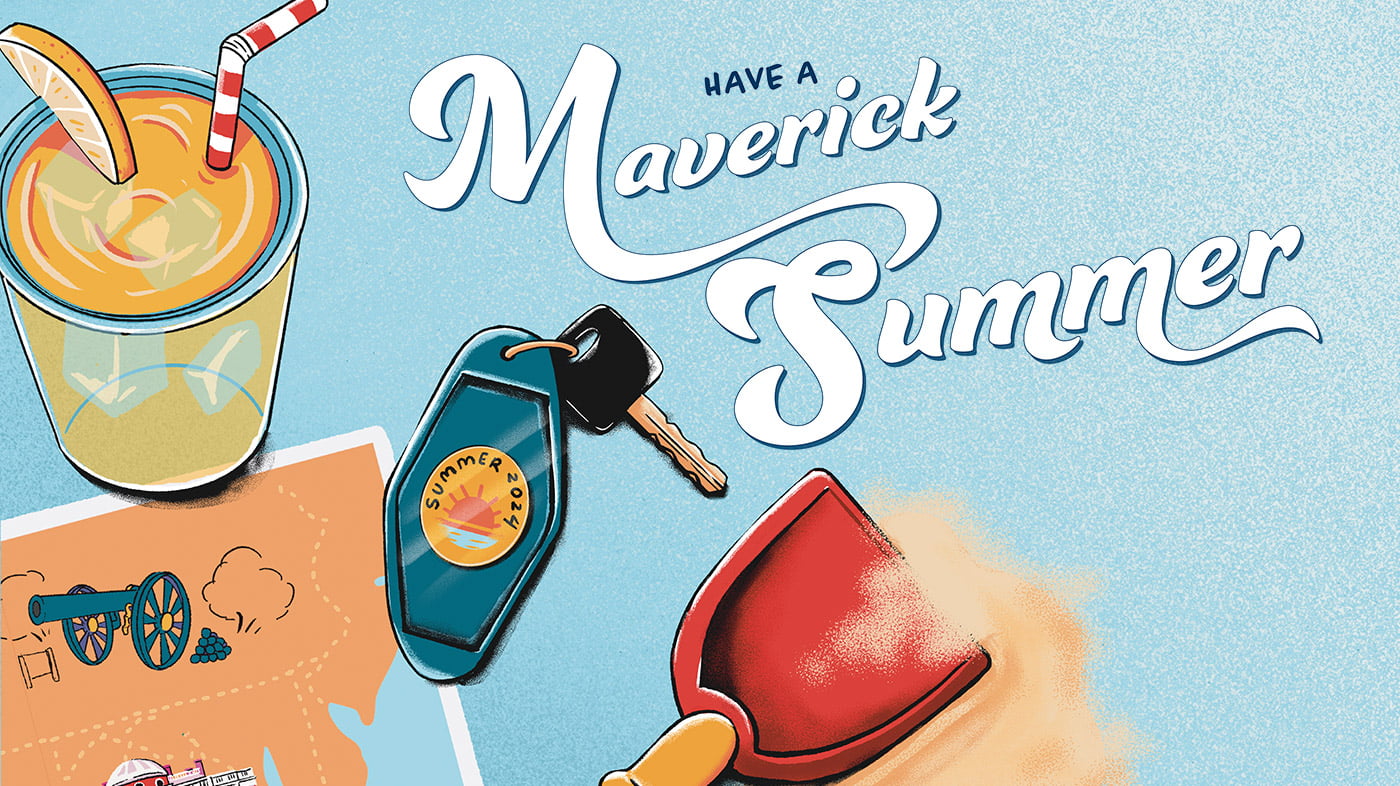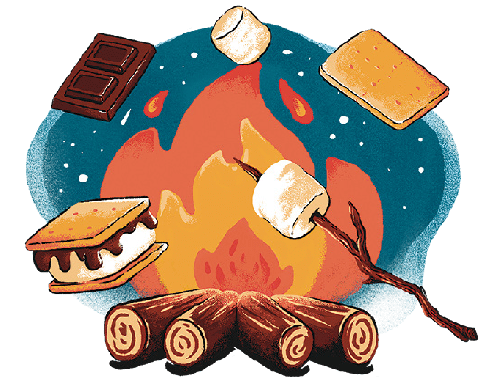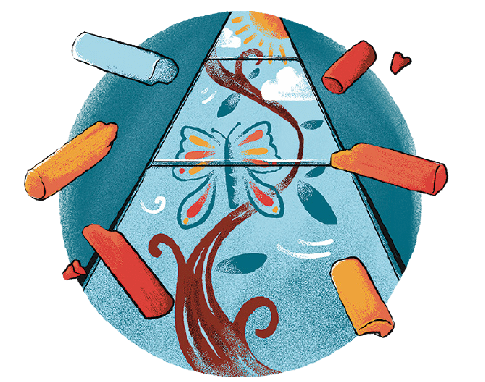University Administration Building
701 S. Nedderman Drive, Ste 421
Arlington, TX 76019-0116

Have a Maverick Summer
Optimize your summer activities with science-backed tips, tricks, and advice from our UTA experts.
Illustrations by Michelle Diaz
This summer, while you’re out there having fun in the sun, we want to make sure you’re getting the absolute most out of every experience. To help you maximize your summer fun, we asked some of our Mavericks to take a break from their cutting-edge research, teaching, and studies to provide their expert guidance and insight on some of our most beloved summer activities.

Build a Better Sandcastle
Do your sandcastles often end up looking more like rapidly crumbling lumps of sand? Xinbao Yu, professor of civil engineering, has science-backed tips to help you turn those misshapen towers into awe-inspiring structures.
Constructing the perfect sandcastle is something that fascinates many kids and even adults, but did you know it’s a subject being studied by geotechnical engineers?
When it comes to sandcastles, the strength of the structure is related to the strength of unsaturated sands, or sands with water and air. The void space between sand particles consists of air, water film, and the surface of sand particles. Capillary force acts on sand particles to hold them together. Simply put, the behavior of sand is controlled by the interplay of sand particles, water, and air, and the amount of water and the sand particle size play a significant role in determining its strength or “cohesion.” The smaller the sand particles, the easier it is for them to stick together with more water bridges among sand particles. For a given sand, an appropriate amount of water will achieve the best results. Too much water will make sand easy to fall apart.
Now that you know the science, here are some tips for building a perfect sandcastle.
- Try to select sand with a good amount of fine particles (size less than 1 mm)
- Spray water mist to wet the sand and mix thoroughly until sand can be compressed into a block without falling apart
- Add an appropriate amount of silt into the sand if it does not stick
- As you build, compact the wet sand in layers
— By Xinbao Yu
Professor of Civil Engineering
Optimal Marshmall Doneness for a S’more
It’s a debate humankind has been waging for at least as long as 1927, when a Girl Scout published the first recipe for a s’more. What's the ideal roasting level for a marshmallow? Burnt to a crisp? Barely warm at all? Somewhere in between? Chemistry doctoral student Ryan Madigan has the answer.
Many people believe that the best marshmallow is one shoved directly into a fire, rendering it a shriveled black mess. These people are wrong, and now you can prove it with science. What is a marshmallow? It is mostly air and sugar, which is why it will shrivel when burnt, releasing air trapped in the sugary matrix. The more important part of this combination of course, is the sugar. So how can we use this fact to influence our cooking decisions? Well, slightly browning sugar will lead to caramelization. This leads to the breakdown of the marshmallow into new molecules that react with each other, producing nutty and buttery flavors. So why not just shove the marshmallow in the fire? Well, another reaction occurring is the Maillard reaction—sugars reacting with the amino acids in the gelatin that occurs at much lower temperatures and leads to complex flavors found in steak, coffee, and caramel. So what is scientifically the best way to cook a marshmallow? Slow and steady over the fire until golden brown, allowing the insides to melt and the outsides to caramelize, creating complex flavors.
— By Ryan Madigan
Doctoral Chemistry Student
Launch a Lucrative Lemonade Stand
Many budding entrepreneurs got their first taste of business world by hosting lemonade stands in their neighborhoods, peddling refreshing drinks to passersby. Jeffrey E. McGee, professor of management and Maverick Entrepreneurship Fellow, offers some quick tips for best practices when you or the kids in your life are ready to dominate the lemonade stand scene.
- Prioritize lemonade quality with the freshest ingredients and unique flavors to nurture customer loyalty.
- Enhance visual appeal by using vivid colors, enticing signage, and themed displays for a memorable customer experience.
- Choose strategic locations with high foot traffic and easy accessibility.
- Train yourself and your team with the skills to deliver engaging customer service.
- Establish competitive prices, balancing your costs and what customers are willing to pay.
- Use social media to build awareness and create buzz, sharing visuals, testimonials, and exclusive deals.
Consistency, adaptability, and continuous improvement are crucial for long-term success in any business. With a superior product, exceptional service, and effective marketing, your lemonade stand is poised for market domination!
Of course, enrolling in UTA’s entrepreneurship program will also help.
— By Jeffrey E. McGee
Professor of Management
Level Up Your Chalk Art
In the waning evening, when the Texas heat fades to something closer to bearable, why not spend some time outdoors decorating your driveway or sidewalk into a gorgeous work of art? "Chalk art is a fun activity that artists at any level can enjoy," says Carlos Donjuan, a noted artist and assistant professor of art. Here, he provides tips for taking your chalk art to the next level.
- Do some research on the ideas that you want to explore and find some good references. For example, if you are making a piece based on birds, select the type of bird(s) that you like and find some good reference images.
- Plan your composition. It can be helpful to photograph the space where you plan to draw and see how your design will fit on the space. If you have access to digital art tools, you can mock up your design ahead of time.
- Supplies and techniques are important to the process. Most chalks will work for sidewalk art. Do your best to find the colors that best match your design and purchase enough materials. If you are working on the floor, having a towel or pads for your knees can make the experience much more comfortable.
- Chalk art can be a little messy, so make sure you wear clothes and shoes that you don’t mind getting a little chalk on.
- Check on the weather and watch out for rain. If you are working in the Texas summer, plan on working in the morning or evenings to avoid long exposure to the heat.
- This type of work can be very physical, so take your time, take breaks, and stay hydrated.
- Make sure to document your work and take photos and video. Chalk art is for the most part temporary, so make sure to preserve the work and the memories.
— By Carlos Donjuan
Assistant Professor of Art
Start a Summer Reading Club
Whether you are a lifelong reader, want to become a reader, or just want an excuse to hide from the heat in an air-conditioned library for a bit, summer is the perfect time to start a book club. Holly Hungerford-Kresser, associate professor of curriculum and instruction and member of the Summasummasummatime Book Club, offers a few tips on how to get started.
- I like to select the first book and then put out feelers asking if anyone is up for chatting about it. Remember, you do not have to start from scratch when selecting a book—there are plenty of celebrity book lists available (e.g., Reese Witherspoon, Oprah, and Barack Obama to name a few), as well as curated lists on sites like Goodreads and from outlets like The New York Times.
- When we meet the first time, in addition to talking about our book, we select someone to choose the next book and host the next discussion; a host comes prepared to guide the discussion as needed.
- Decide how long people will need to read or listen to the book and how many books you want to read over the course of the summer. Then select dates and times to accommodate most people’s needs. Having these dates set early on is particularly helpful in summer when schedules tend to be more scattered.
- In thinking about the where, it is important to decide if your book club will be in person, virtual, or hybrid. This can change meeting to meeting, depending on host and participants, and each has benefits. However, I have found hybrid meetings allow for the most flexibility for everyone concerned and in-person meetings allow for the best snacks.
- As for the why: If you like books and (most) people, the question is really why not give it a try?
— By Holly Hungerford-Kresser
Associate Professor of Curriculum and Instruction
See the Brightest Stars
With clear skies and much more tolerable temperatures at night, summer is a great time to get outside and take in the universe. Levent Gurdemir, director of the UTA Planetarium, tells you which celestial bodies to look out for in the summer, some even without the help of a telescope—though if you have one, that’s a definite plus.
Summer Triangle and the Ring Nebula
High up in the sky there are three bright stars forming a big triangle: Altair, Deneb, and Vega. They are the main stars of the constellations Aquila, Cygnus, and Lyra, respectively. The Albireo double star system is located on the bottom of Cygnus, and beautiful Ring Nebula is located in Lyra. Both can be enjoyed with a telescope.
The Big Dipper and North Star
Can you point north without using your phone? If you know the Big Dipper constellation, it is easy to find the faint North Star. The North Star not only marks the geographical north, but also tells us what geographical latitude we are on. This feature of North Star was used by sailors traveling around the world well before the launch of GPS satellites, and it’s still a backup for pilots in case of electronic systems emergencies.
Jupiter and Saturn
You can enjoy the views of Jupiter and Saturn in the later summer months after midnight. Both of the planets will be bright and visible, and even small telescopes will be great for viewing the celestial bodies and spotting their moons.
The Perseid Meteor Shower
The Perseid meteor shower peaks August 12 and 13 this year, giving viewers the opportunity to spot some shooting stars.
— By Levent Gurdemir
UTA Planetarium Director
Take a Road Trip Through American History
Summer is often a time to hit the road and see what the United States has to offer beyond your corner of the world. While you’re already planning to head out, why not also plan to make the trip meaningful and educational? Stephanie Cole, associate professor and chair in the Department of History, maps out an epic road trip that brings significant pieces of American history alive—all of which coincide with themes covered in one of her favorite courses to teach, “U.S. History to 1865.”
Click on each image to expand it.
-
Cahokia Mounds State Historic Site in Collingswood, Illinois
A ten-hour drive from Arlington, Cahokia provides dramatic evidence of the achievements of a wealthy civilization that existed on the North American continent long before any Europeans arrived. The site contains 80 giant earthen mounds, built over decades with exclusively human labor. Don’t miss climbing to the top of Monks Mound, which is 10 stories high and covers almost 14 acres. Along with evidence of a remarkable solar calendar and elaborate burial remains, this Mound bears witness to the complexity and advancement of pre-Columbian society.
-
Monticello—Jefferson’s home near Charlottesville, Virginia
From Cahokia, you’ll want to travel 750 miles (and four centuries forward in time) to the home of the author of the Declaration of Independence and the nation’s third president, Thomas Jefferson. Known as Monticello, this home and its surrounding grounds attest to Jefferson’s curiosity, inventiveness, botanical knowledge, and love of books. (His library helped save the Library of Congress after the British burned much of the capitol in 1812.) The full tour provides evidence not only of Jefferson’s unique gifts as a scholar and politician but also the ways in which the institution of slavery was integral to his worldview and supported a life dedicated to philosophy, politics, and research of the natural sciences.
-
Shaker Village of Pleasant Hill in Harrodsburg, Kentucky
Driving 450 miles westward will find you at Pleasant Hill, a restored site of a community built in 1805 and occupied until 1910 by the Shakers, a sect of Quakers founded by Mother Ann Lee in the 1770s in Britain. At the height of the Shakers’ appeal in the mid-nineteenth century, Pleasant Hill, with at least 500 residents, was the third largest Shaker community among at least sixty such communities located in the United States. Learning about life there tells us much about how rapid changes associated with an industrial and technological revolution in antebellum America prompted social upheaval and not a small amount of social experimentation. Successful proselytizing—particularly among women—and their practice of adopting orphans allowed the community to thrive. They became widely known for their industry, agricultural know-how, and having invented the flat broom—as well as their unique “shaking” dances and dedication to celibacy by both male and female members.
-
Gettysburg National Military Park in Gettysburg, Pennsylvania
Our last stop will take another 530 miles, but it will bring us to Pennsylvania where in July 1863, Confederate General Robert E. Lee hoped to break the will of those fighting secession by achieving a victory on northern soil. Walking the battlefield and learning from the site’s exhibits underscore that Lee’s defeat—and the astonishing losses of both Union and Confederate troops—made Gettysburg one of the most critical battles of the Civil War. It was also the place where President Abraham Lincoln delivered the Gettysburg Address in November 1863, when Americans gathered to consecrate the one-time battlefield as a national cemetery. Lincoln’s stirring words remind us that how we remember those who died in service to the nation carries an essential lesson in civics. When we learn of them, and then resolve that their deaths were not in vain, the nation “shall have a new birth of freedom—and that government of the people, by the people, for the people, shall not perish from the earth.”
Driving from Pennsylvania back to our home in Texas will take almost 20 hours of driving time. Plenty of time to reflect on these and other lessons of history along the way. Road trips, if properly planned, illustrate just how full of history this country is. Time to get behind the wheel!
— By Stephanie Cole
Associate Professor and Chair, Department of History
YOU MIGHT ALSO LIKE

Innovation Winners
Four senior bioengineering students put what they have learned about technology and business into action, earning the Biomedical Engineering Society (BMES) Coulter College for Healthcare Innovation competition.

Gallery
In a farewell tribute to Benito Huerta’s 26 years at The University of Texas at Arlington, The Gallery at UTA showcased two concurrent exhibitions of his work, Profane Truths and Sacred Lies and Post Modern Fulcrum.

Talk
Meet junior Business Management student Benjamin Kocurek.




